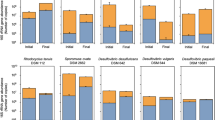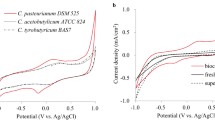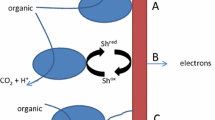Abstract
Desulfitobacterium hafniense strain DCB2 generates electricity in microbial fuel cells (MFCs) when humic acids or the humate analog anthraquinone-2,6-disulfonate (AQDS) is added as an electron-carrying mediator. When utilizing formate as fuel, the Gram-positive, spore-forming bacterium generated up to 400 mW/m2 of cathode surface area in a single-chamber MFC with a platinum-containing air-fed cathode. Hydrogen, lactate, pyruvate, and ethanol supported electricity generation, but acetate, propionate, and butyrate did not. Scanning electron microscopy indicated that strain DCB2 colonized the surface of a current-generating anode but not of an unconnected electrode. The electricity was recovered fully within minutes after the exchange of the medium in the anode chamber and within a week after an exposure of a colonized anode to 90°C for 20 min. Of the six strains of Desulfitobacteria tested, all of which would reduce AQDS, only D. hafniense strain DCB2 continued to reduce AQDS and generate electricity for more than 24 h, indicating that reduction of the humate analog alone is insufficient to sustain electrode reduction.





Similar content being viewed by others
References
Bond DR, Lovley DR (2003) Electricity production by Geobacter sulfurreducens attached to electrodes. Appl Environ Microbiol 69:1548–1555
Bond DR, Lovley DR (2005) Evidence for involvement of an electron shuttle in electricity generation by Geothrix fermentans. Appl Environ Microbiol 71:2186–2189
Bond DR et al (2002) Electrode-reducing microorganisms that harvest energy from marine sediments. Science 295:483–485
Cervantes FJ et al (2002) Reduction of humic substances by halorespiring, sulphate-reducing and methanogenic microorganisms. Environ Microbiol 4:51–57
Chaudhuri SK, Lovley DR (2003) Electricity generation by direct oxidation of glucose in mediatorless microbial fuel cells. Nat Biotechnol 21:1229–1232
Cheng S et al (2006) Power densities using different cathode catalysts (Pt and CoTMPP) and polymer binders (Nafion and PTFE) in single chamber microbial fuel cells. Environ Sci Technol 40:364–369
Finneran KT et al (2002) Desulfitobacterium metallireducens sp. nov., an anaerobic bacterium that couples growth to the reduction of metals and humic acids as well as chlorinated compounds. Int J Syst Evol Microbiol 52:1929–1935
Holmes DE et al (2004a) Electron transfer by Desulfobulbus propionicus to Fe(III) and graphite electrodes. Appl Environ Microbiol 70:1234–1237
Holmes DE et al (2004b) Microbial communities associated with electrodes harvesting electricity from a variety of aquatic sediments. Microb Ecol 48:178–190
Holmes DE et al (2004c) Potential role of a novel psychrotolerant member of the family Geobacteraceae, Geopsychrobacter electrodiphilus gen. nov., sp. nov., in electricity production by a marine sediment fuel cell. Appl Environ Microbiol 70:6023–6030
Kim HJ, Park HS, Hyun MS, Chang IS, Kim M, Kim BH (2002) A mediator-less microbial fuel cell using a metal reducing bacterium Shewanella putrefaciens. Enzyme Microb Technol 30:145–152
Liu H, Logan BE (2004) Electricity generation using an air-cathode single chamber microbial fuel cell in the presence and absence of a proton exchange membrane. Environ Sci Technol 38:4040–4046
Lovley DR (2006) Bug juice: harvesting electricity with microorganisms. Nat Rev Microbiol 4:497–508
Lowy DA et al (2006) Harvesting energy from the marine sediment-water interface II. Biosens Bioelectron 21:2058–2063
Milliken CE, Meier GP, Watts JEM, Sowers KR, May HD (2004) Microbial anaerobic demethylation and dechlorination of chlorinated hydroquinone metabolites synthesized by basidiomycete fungi. Appl Environ Microbiol 70:385–392
Niggemyer A et al (2001) Isolation and characterization of a novel As(V)-reducing bacterium: implications for arsenic mobilization and the genus Desulfitobacterium. Appl Environ Microbiol 67:5568–5580
Park DH, Zeikus JG (2000) Electricity generation in microbial fuel cells using neutral red as an electronophore. Appl Environ Microbiol 66:1292–1297
Park DH, Zeikus JG (2003) Improved fuel cell and electrode designs for producing electricity from microbial degradation. Biotechnol Bioeng 81:348–355
Park HS, Kim BH, Kim HS, Kim HJ, Kim GT, Kim M, Chang IS, Park YK, Chang HI (2001) A novel electrochemically active and Fe(III)-reducing bacterium phylogenetically related to Clostridium butyricum isolated from a microbial fuel cell. Anaerobe 7:297–306
Rabaey K, Boon N, Siciliano SD, Verhaege M, Verstraete W (2004) Biofuel cells select for microbial consortia that self-mediate electron transfer. Appl Environ Microbiol 70:5372–5382
Rabaey K, Boon N, Höfte M, Verstraete W (2005) Microbial phenazine production enhances electron transfer in biofuel cells. Environ Sci Technol 39:3401–3408
Reguera G et al (2005) Extracellular electron transfer via microbial nanowires. Nature 435:1098–1101
Reimers CE et al (2001) Harvesting energy from the marine sediment-water interface. Environ Sci Technol 35:192–195
Tender LM et al (2002) Harnessing microbially generated power on the seafloor. Nat Biotechnol 20:821–825
Zhao F et al (2005) Application of pyrolysed iron(II) phthalocyanine and CoTMPP based oxygen reduction catalysts as cathode materials in microbial fuel cells. Electrochem Commun 7:1405–1410
Acknowledgments
This research was supported with funds from the National Institutes of Environmental Health Sciences (grant ES012815-01) and National Aeronautics and Space Administration (grant 897-7557-223-2094553/01-0). The authors would like to thank Tom Shaak (United States Air Force) for the assistance in the monitoring of the fuel cells, Carol Moskos (MUSC) for the assistance and instruction on the operation of the SEM, and Steve Creager (Clemson University) for the technical advice on fuel cells.
Author information
Authors and Affiliations
Corresponding author
Rights and permissions
About this article
Cite this article
Milliken, C.E., May, H.D. Sustained generation of electricity by the spore-forming, Gram-positive, Desulfitobacterium hafniense strain DCB2. Appl Microbiol Biotechnol 73, 1180–1189 (2007). https://doi.org/10.1007/s00253-006-0564-6
Received:
Revised:
Accepted:
Published:
Issue Date:
DOI: https://doi.org/10.1007/s00253-006-0564-6




